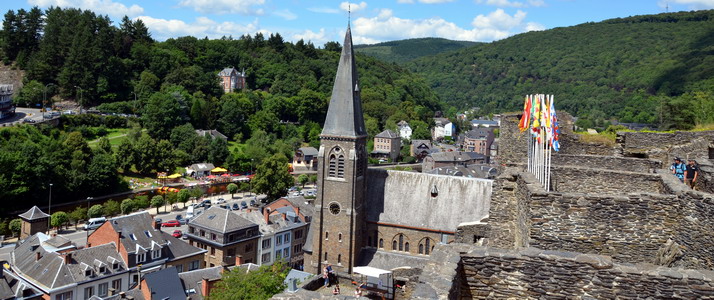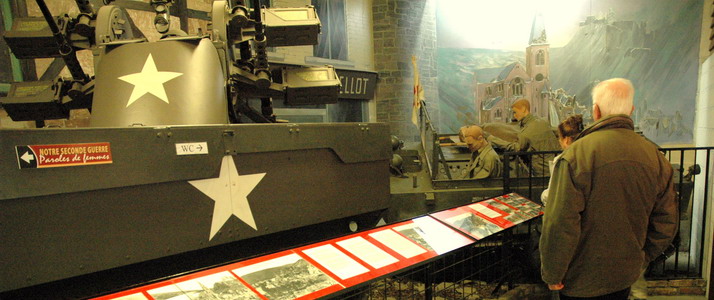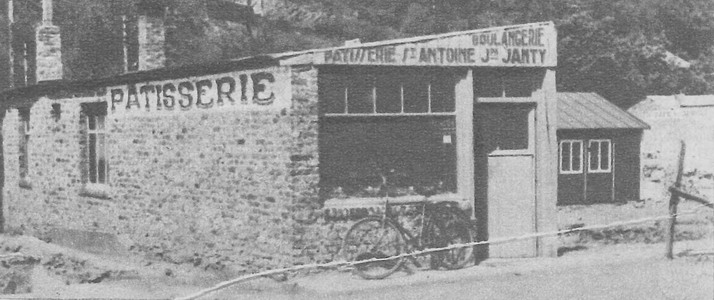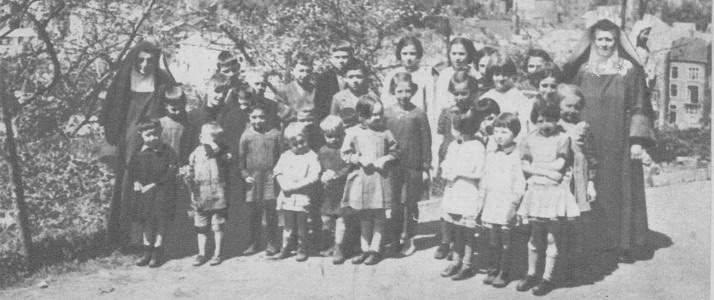The post-war reconstruction
1
juin
2015
Par Fanny Lardot 1 juin 2015 Pas de commentaires
The investigation of a journalist of those days : how does La Roche rebuild itself ?
Rummaging through my grandparent’s attic, I happened upon some old press articles dating back to the immediate post-war period. One of them particularly caught my attention. It relates to an investigation by Roger Crouquet, for Le soir illustré(19 May 1946), relating the reconstruction of La Roche after the Battle of the Bulge. By these descriptions, we can better understand the difficult situation in which our elders lived.
Your turn to discover the ups and downs of such a reconstruction.
« The Ardennes are singing in the calm atmosphere of a bright spring (…) The Ardennes sing and call us : the songs of the winding rivers that worm their way through the rocks, song of the tender green foliage that a light wind rustles, song of the birds calling in the shrub, song of the countryside where the rugged Ardennes’ farmer works a soil that is not always generous, song of the workmen at work on the reconstruction sites of deceased cities.
One year after the battle, we have returned to these regions of which we had kept a tragic souvenir. We did not see again the horrible vision of ripped open towns, of bodies huddled up under a shroud of snow and crosses on the roadsides. Indeed traces of the conflict remain. It’s not in one year that we can erase the many scars dug in the earth, on the stones as witnesses of the madness of mankind. It will take years for La Roche, Houffalize, Bastogne, to mention only these, to recover their peaceful look of pre-war years. But it’s unquestionable that a commendable effort has already been made, if not to reconstitute their original aspect, at least to give them back life, which is essential. The heroic towns of our Ardennes will remain disfigured for a long time still for the reconstruction problem in our country is far too vast and the ruins will only be replaced following a plan stretched over a long period.
What we should have to resuscitate our Ardennes, is a magic wand. Unfortunately! Our ministers do not have this accessory which would however be of great help to them. By lack of money, because it must be said, it’s the sinew of war, and also in this occurrence, the sinew of peace that we lack most, we have had to stop at a programme in two points: patch up what can still be repaired and build huts to lodge the disaster victims. It’s little and already a lot; little, because the people concerned were hoping to get their war damage funds and be able to rebuild their homes ; a lot when one considers the state of our finances, the too heavy rates that weigh down our Treasury and the slowness of the administration.

-I’m waiting for a letter, is it for today ?
- I’ll have a look Miss.
Le Soir illustré, 1946 the postman
We wanted, with a completely impartial view, to run an investigation on the reconstruction of our Ardennes and we went to La Roche, one of the towns having most suffered during the von Rundstedt offensive. One hundred and seventeen civilians were killed, three hundred and fifty buildings were completely demolished, three hundred and twenty seven badly damaged. Only four houses could be considered « intact ». We had seen the poor La Roche when the British and Americans were advancing on either side of the Ourthe, to come and liberate the town. It was only a mound of rubble under the white coat of snow. Hallucinated people, with eyes unnaturally wide open with terror evoked the horrendous days of the bombardments. Having sought refuge in a farmhouse, the Petite Strument, lying on the frozen ground, they had lived through hours of anxiety. And they were trembling of fright,cold and nervousness. Many of these people have died since. The shock had been too violent. They could not resist.
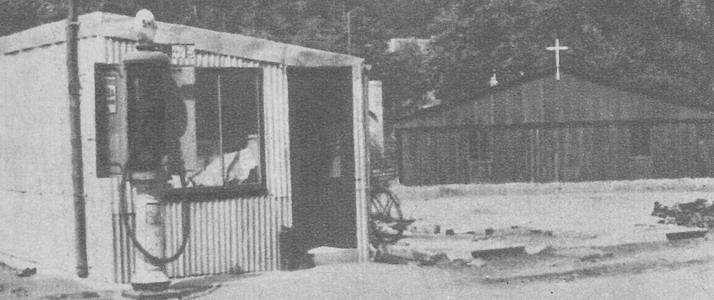
Do you want gas ? See inside this corrugated iron hut. On the
right,the new wooden church of La Roche.
Le Soir illustré, 1946 service station
Today, be it not for the church spire and the ruins of the old castle, one would not recognize La Roche. The skeletons of houses, the unsteady walls, have disappeared. The buildings that threatened to crumble have been erased down to the cellars. The ground is level and the rubble removed. A new town has rapidly grown, as a mushroom. Is it pretty? Is it ugly? It’s horrible. This town of huts that the locals have named Matadi, which is assuredly being unfair to our Congolese port, has no character. It’s as if a malicious giant, carrying some eighty huts of all shapes, materials and sizes in his apron, had climbed the Corumont hill. Then, from up there, suddenly shaking his apron, scattered its contents in the valley. That’s the impression we got from this ill-assorted lot of pavilions scattered all over, without order and certainly without any consideration of aesthetics. One could certainly have done better. Chosen a unique type of hut and organized a competition amongst our architects. We envisage very well blending with the sites of our Ardennes, a sort of rustic chalet covered in pine bark.
And what about comfort ? It’s just as easy to make comfortable a chalet with harmonious forms (see Switzerland) than a rectangular hut, Buchenwald style. Anyway, let’s not speak of a rope in the house where someone hung himself and the comfort of the huts in La Roche certainly lack comfort. The majority of pavilions have no running water and no toilets, which is incredible.
On the other hand, they are finishing for the moment the setting up of some « tubes », these cylinders of sheet-iron so disparaged by our lads in Ireland. The « tubes » are divided in two. Each household will dispose of a kitchen and two small bedrooms of approximately 2m15 on 1m90, far from enough space to put a bed, a chair and a cupboard. People hesitate to occupy these cylinders, preferring their actual misery.
Others are resigned « What can I say » said a disillusioned man, « I must go somewhere. I’ve been without a lodging for sixteen months. I’m a widower. My children live in one place and me in another ».
We listened to the grievances of the population of the village of « Matadi ». Emotional concert of complaints and recriminations. We visited the three-room huts occupied by shop keepers, craftsmen, who cannot decently live and also exercise their trade in them.
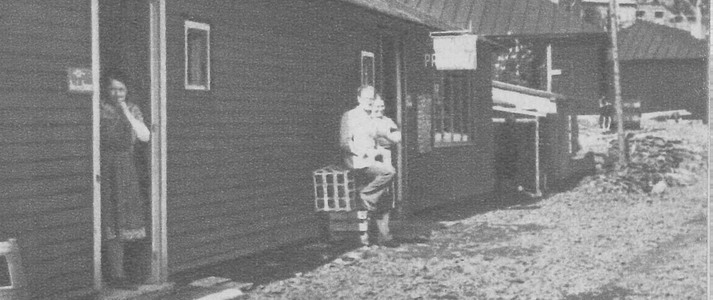
In the village of Matadi, one even finds fresh vegetables. The
shop keepers have sacrificed their lodging to set up a shop. They
grumble, complain, but nevertheless have a smile.
Le Soir illustré, 1946 shop keepers
One of the disaster victims complained to Brussels, insisting that there should be toilets in the huts. He got this astonishing reply : »Toilets… you only need to dig a hole… »
As you can see, the situation could be better. However, it’s already splendid to have achieved the extraordinary feat of bringing back life to a town that was wiped out. Because La Roche is well alive. There is in this hive,at the approach of the summer season, a great activity. Some hotels have already reopened their doors and await the tourist, because the environing sites were not destroyed! The managers of the Tourist Office have not lost their time. The walks are accessible to the public. They are lined with inscriptions and signposts. Benches will very shortly be installed. The whole region has been cleared of mines. One forecasts, for a very close future, the opening of a bus line between Marloie and La Roche and vice-versa. This will greatly facilitate communications between the capital and the valley of the Ourthe. Two hundred rooms will be put, this summer, at the disposal of the clients of hotels and boarding houses.
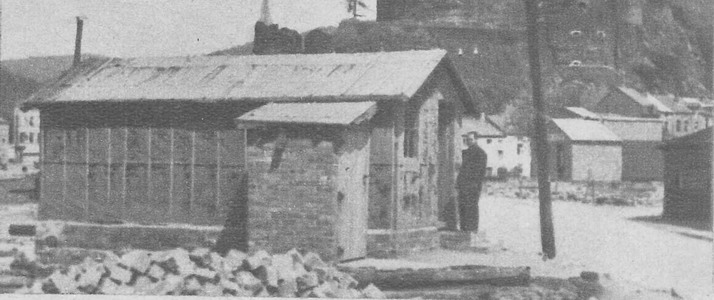
The telephone exchange of La Roche from where you can speak
to the rest of the world.
Le Soir illustré, 1946 telephone exchange
The « Rochois » are rolling up their sleeves and working. They make it a point of honour to be ready to joyously welcome the outsiders . The mayor, M. Jean Orban de Xivry, of whom the courageous conduct during the offensive deserves praise, spoke to us in length of his beloved town. He knows all the inhabitants:
The »Rochois », says the mayor, always complain as do all the Belgians. You have seen what has already been done thanks to the know-how and energy of Mr Dachy and Glaudot, respectively director of repair services and chief of the huts. But are unfortunately impeded by the lack of money and materials. We have already reached our maximum of allocated credit. So, we must wait. Likewise, we still don’t know the amount of war damages that we will get. Nobody dares take action without knowing. But everything will come together. »
The mayor is optimistic. In front of his damaged and very badly repaired villa, he adds : « I’m a disaster victim and therefore resigned. » Let’s hope that the public authorities will give satisfaction to the population of La Roche and to the other victims of the Ardennes who are certainly not asking for the moon. All they want is to lead, as before, a decent life.
The people of the Ardennes have, during the German offensive of 16 December 1944, drawn a draft on Belgium. The time has come to pay it. »
CROUQUET Roger, « On the Ardennes’ building sites »,
Le Soir Illustré, 9 mai 1946
Discover in reality
-To discover the « La Roche-en-Ardenne » of today, one of the major tourist towns of Belgian Luxembourg, the syndicat d’initiative and the Maison du Tourisme are at your service.
Contact : Place du Marché 15
6980 La Roche-en-Ardenne
Tél.: +32 (0)84 36 77 36
Fax: +32 (0)84 36 78 36
info@la-roche-tourisme.com
